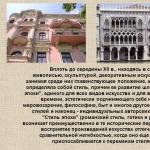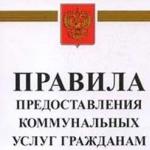Where are Zhostovo trays made? Zhostovo trays – traditions and modernity. The origins of Zhostovo crafts
Zhostovo painting- a long-standing Russian tradition that appeared in the first quarter of the 19th century on the territory of the village of Zhostovo near Moscow, after which the fishery got its name. At first, in workshops that opened in several neighboring villages, they painted exclusively papier-mâché items. And only almost a hundred years later, in 1922, the Novoseltsovskaya labor artel began producing metal varnished trays, and artists began to paint new products for themselves.






Zhostovo painting in our time
Today, masters of Zhostovo painting create unique forged metal trays, which can be viewed at the link http://imatreshki.ru/magazin/folder/zhostovskie-podnosy and used both for purely utilitarian purposes, such as serving dishes on the table, and as a decorative element. The main motive of the painting is a bouquet of a simple composition, which contains both small and large flowers. According to the established tradition, painting is done on a lacquered black background, but sometimes trays of green, red, silver and blue are used. Sometimes white and dark red colors may be used. The trays themselves can have different shapes:
Round or oval - these are the classic shapes of Zhostovo trays;
- rectangular;
-octagonal - a very interesting shape for decorative elements;
- combined and others.
Today Zhostovo trays are one of the most popular products, which can be used as a stylish and expensive gift for any occasion.
Where to use trays with Zhostovo painting
The main motive of the painting, as mentioned above, is a fairly simple bouquet of flowers. But in general, Zhostovo products are very diverse in theme. This is a bizarre interweaving of leaves and branches, berries and fruits, birds among flowers, simple and complex ornaments, and even the use of elements of Khokhloma and Gzhel painting.
Amazingly beautiful painted trays are used very widely in everyday life. The very first thing that may come to a designer’s mind is to use these souvenirs to decorate the room. A colorful tray can become a central element of the interior, a semantic and color accent that can literally transform a room.
Another application is elite table setting for an important occasion. family celebration. A painted tray will perfectly emphasize the significance of the moment, and at the same time become evidence of the impeccable taste of the owners.
It’s easy to purchase trays with Zhostovo painting. You just need to visit the website of the company “Ai, Matryoshkas”, select a product from the catalog and place an order. The tray you like will appear in your home very soon.
Perhaps everyone has at least once seen iron trays with bright paintings on a black background. And many people have one of these at home. Bright, brilliant compositions, striking with their variety of colors, are business card craftsmen of the village of Zhostovo. Even though this folk craft developed only two centuries ago, it has a curious history of its development.

It is generally accepted that the craft of painting metal trays originated in the first quarter of the 19th century in several villages of the Trinity volost (today Mytishchi, Moscow region). The former serf brothers Vishnyakov, who managed to buy their freedom, settled in the village of Zhostovo and opened a workshop in which they were engaged in varnish painting of papier-mâché products - boxes, cigarette cases, crackers. By 1830, they abandoned papier-mâché in favor of metal trays.

The trade began to bring in good income, so craftsmen from nearby villages took up the same craft. The proximity to the capital made it possible to establish a sales market without intermediaries, and materials for work could be purchased at affordable prices.


After the revolution, the demand for Zhostovo products fell slightly, which is why artists from Troitsky, Novosiltsev, and Zhostovo united into the Metallopodnos artel. The war years were catastrophic for artisans. In order to somehow survive, they began to produce children's painted toys, the demand for which was much higher than for trays.

Everything changed during the reign of Nikita Khrushchev. By order of the Secretary General, in 1960, the Metallopodnos artel underwent reorganization and was renamed the Zhostovo Decorative Painting Factory. The Thaw allowed craftsmen to send their products to international exhibitions, orders appeared from abroad, and the factory gradually emerged from the crisis.
“Zhostovo or the secret of a velvet bouquet. (Excursion Zhostovo-Fedoskino)”... The factory consists of ordinary gray buildings elongated in breadth and height. It is located a little away from the village of Zhostovo. A beautiful sign on the road in the form of a flower tray leads to it.
…A “visit” to a factory store can hardly be called just a visit. Most likely, it was worse than the Tatar-Mongol attack on the Russian settlement, except without the haze of fires in the ruins.
... What was going on there is indescribable. The sailors who took the Winter Palace are smoking nervously on the sidelines. The soundtrack was, excluding Russian folk expressions, something like this: “Where... damn... goat... scoundrel... are you climbing... give me... ah... oh... now I’ll tell you... like that myself, etc.”
We approach the pretty village of Zhostovo, it feels like there are trays in every home. :) The bus travels along a narrow village street bordered by snow-covered birches and, following a beautiful sign in the form of a flower tray, turns onto the road to the Zhostovo factory.
Factory in Zhostovo 
Factory It is an ordinary gray body elongated in breadth and height. It is located a little away from the village. In the lobby they give out covers for shoes, we hand things over to the locker room, and crowd around a woman artist sitting by the window at a table. She, apparently, is waiting for us and begins to draw. She has a small black tray on her lap, a palette of paints on the table, and her hand rests on a ruler so as not to smear the drawing. But first she passed the hard end of the brush over the tray several times. " Why are you crossing the tray?“- she was immediately asked from our crowd. " This is me marking the center of the composition“- answered the artist. She still paints “paints” with whitewash, but the feeling when you watch her is amazing. A confident hand, soft strokes, literally 5 minutes later a wonderful pink bouquet appeared out of nowhere. I can already distinguish in it the future rose and apple blossoms. Judging by the beauty of the composition, you understand that this tray is drawn seriously, and not just for the amusement of the arriving audience. Although some of the public is already dissatisfied: “ Well, let's finally go to the magic...m-m-museum! " - the capricious voice of some impatient aunt is heard.
A “visit” to a factory store can hardly be called just a visit. Most likely, it was worse than the Tatar-Mongol attack on the Russian settlement, except without the haze of fires in the ruins. Let's start with the fact that halfway through the guide's story in the Zhostovo Museum, the caps of a group of running women from our bus flashed behind the windows facing the street. They ran in the direction of the store (entrance is from the street). The leader, obviously, was the same lady who was very nervous about the “slow” working artist. The desire to rush off to the treasured store with her friends as soon as possible was beyond her already low standards of decency.
After the official end of the tour, everyone was invited to visit the factory's signature tray store. The entrance to it was located outside the museum, at the beginning of the factory building itself, and was decorated with a poster with Zhostovo painting. Almost the entire remaining mass of the bus rushed there, headlong and forgetting to remove the polyethylene bags from their boots.
What happened there is indescribable. The sailors who took the Winter Palace are smoking nervously on the sidelines. I already wrote about the “costs” of a bus tour in this regard in a story about Gzhel; barely restraining herself, she indicated “this” in the story about Fedoskino; but here it is very difficult to describe what our people are doing in the wake of buying fever in ordinary words.
Shop. Trays 
You know, as a child I had a favorite book “The Adventures of Dunno” with wonderful drawings by Valka. So, the funny drawn relationships between the incredibly funny little guys really reminded me of the atmosphere in the store.
In one corner, two women in long fur coats were puffing and pulling one tray in different directions. Don't believe me? :) He was the only one - with rowan trees. So they divided it. Naturally the strongest one won. In another corner, someone was on someone else's shoulders, removing attached trays from the wall. The first wave of lucky ones tightly cemented the approach to the counter. The second wave took the first by storm in the form of a ram, i.e. with a running start she hit the shaggy fur coated backs that stood like a monolithic wall. The soundtrack was, excluding Russian folk expressions, something like this: “ Where... damn... goat... scoundrel... are you climbing... give me... ah... oh... right now I’ll tell you... like that myself, etc.." The saleswoman behind the counter shouted at the shout: “ People, where, where did you take this tray... why are you taking it off... oh, what are you doing... ahh».
Of course, at first I wanted to pretend to be a proud girl with my head held high and wait out this whole collective farm on the street. But then I quickly assessed the harsh realities and realized that in this situation I would not bring home anything at all - the people there were buying trays in unimaginable quantities, almost in bulk. Therefore, remembering my favorite exercise equipment, yoga and Cuban dancing at the World Class I once visited, I rushed to climb the shaggy fur coats. From what I remember: it seemed like, having broken through the defense, I grabbed some kind of black tray standing along the walls; grabbed one white one on the wall; and pulled towards her a small light green one that someone had dropped. It arrived at the cash register - I paid. Then the people's wave threw him against the wall. But I'm with trays! :) Why grumble! :)
Queue for trays 
The funny thing is that in the middle of it my husband called. How can I answer this - I’ve almost climbed through! :):) Hearing the noise and sounds of battle, my husband asked: “ Where are you?» - « In the museum“,” I said, breathlessly, punching a hole for myself, under someone’s furry sleeve. " What are you doing there?“- the husband was genuinely surprised.
But I had no time to answer; my hand, stuck into the hole, had already found something invisible and hard on the counter, and I had no time to talk.
In general, now, like a seasoned bison, I can now give advice for free. If you arrived by bus, then you need to choose comrades - either songs or dances. That is, you either fully enjoy the excursion - you stay in the museum and talk with the guide, or you also fully satisfy your natural shopping needs - immediately upon arrival you sneeze at the museum and go to the store. There is also a third option: you visit the museum and wait out the heat of passion in a store on the street, but then all you have to do is buy up the remnants of the former luxury on the counter and a wide assortment of remaining designer trays from 10 thousand rubles. :). There is another option - to calmly buy these trays in their showroom at the All-Russian Exhibition Center - but this, you see, is not at all the same! A trophy obtained in hand-to-hand combat is much dearer to the heart than one bought insipidly. :) And there is one simply different (from others :)) option. Take a car and come to Zhostovo. Arrange for a tour at the factory. Calmly come, calmly look and calmly buy trays (I can’t even believe that this happens).
Yes, that's what I bought. I could only see it at home. My artistic eye did not let me down even in such a “heated” environment. A black rectangular one - with bright red roses, a white round one - with a bouquet of wildflowers, and a small bright lime one with bells and yellow water lilies. From the signature I realized that one of them was drawn by the same artist who showed us the master class. Nice.
Shop. Trays 
Now you need to master the ingenious design of 3 loops for fur coats strung on a string, and hang this beauty on the wall. And on green I will serve guests apple jam and Tula printed gingerbread cookies :).
Nikolai Antipov's tray. "Flowers on a golden background." Photo from the museum 
Zhostovo painting is a Russian folk craft consisting of painting metal trays, invented in the village of Zhostovo, Moscow region.
What do foreign tourists bring from Russia? What souvenirs do you prefer? Among the traditional items of Russian folk crafts are the works of Zhoskov craftsmen - painted metal trays. Zhostovo painting is a Russian folk craft consisting of painting metal trays, invented in the village of Zhostovo, Moscow region.
The history of painting on metal trays.
Painting of metal trays arose in the mid-18th century in the Urals, where metallurgical factories were located, and only in the first half of the 19th century the craft became popular and migrated to the villages of the Moscow region - Zhostovo, Troitskoye and others. Behind short time Zhostovo painting became the leading one. Nowadays, the production of trays with this painting is concentrated in the village of Zhostovo and Nizhny Tagil.
The history of the Zhostovo craft dates back to the beginning of the 19th century, when workshops for the production of painted lacquered items from papier-mâché arose in several villages and villages near Moscow - Zhostovo, Ostashkovo, Khlebnikov and others.

In 1825, miniaturist O.F. Vishnyakov, the son of the owner of a Moscow factory for the production of painted metal trays, founded a workshop in Zhostovo where they created trays with subject and flower painting. The Vishnyakovs’ price list stated: “The Vishnyakov brothers’ establishment of lacquered metal trays, breadcrumbs, pallets, papier-mâché boxes, cigarette cases, teapots, albums, etc. has existed since 1825.” In 1922, in the village of Novoseltsevo, the “Novoseltsevo Labor Artel” arose to produce lacquered iron trays; in 1924, the Zhostovo Labor Artel and Spetskustar were organized in villages; in 1925 - “Vacifier” and at the same time in the village of Troitskoye - the “Own Labor” artel for painting trays. All of them were united in 1928 into a specialized artel “Metal Tray” with a center in the village of Zhostovo.
The 1920s - 1930s were not easy in the history of Zhostovo. The general tendencies of the straightforward affirmation of modernity and realism in Soviet art led to the fact that the organizations in charge of folk crafts tried to change the traditional direction of their development and introduced into Zhostovo painting samples of ornamental and thematic compositions created by professional artists without taking into account the specifics of local art and bearing features of easel and naturalism. Leading artists understood the alienness of such innovations from the very essence folk art, managed to resist them and direct new ideas to deepen traditional craftsmanship. In the 1960s, a new stage in the history of Zhostovo began, which continues to this day.

Features of the production and painting of Zhostovo trays
The main feature of Zhostkovo painting is a floral bouquet predominantly on a black or red background. Much less often other colors serve as the background. A traditional feature of painting is the improvisational performance of each individual composition. The artist does not paint from life or based on models, but is guided by his imagination and compositional techniques, so no two trays are alike. There are several established types of compositions. Flowers can be placed in garlands around the perimeter of the tray, collected in bouquets of three or five flowers, or displayed in baskets. Flowers are often accompanied by images of fruits, berries or birds.
Another feature of the production of Zhostovo trays is the use of thin roofing steel: the sheets are stamped, then the trays are rolled to give rigidity to the sides. After this, the trays are primed, sanded and coated several times with oil varnish, usually black, drying each layer in an oven. Then the craftsmen hand-paint the trays oil paints without the use of stencils and samples, relying on your own imagination.
Painting is usually done on a black background (sometimes on red, blue, green, silver), and the master works on several trays at once. The ornamental pattern is applied with “created” gold (gold powder diluted in transparent varnish or turpentine) or Gulfarba (white paint with varnish), which is sprinkled with aluminum powder. The main motif of the painting is a simple floral bouquet in which large garden and small wildflowers alternate. First, shading is done (the main silhouettes of the bouquet), then straightening: shadows are applied, light places are painted, dense strokes, highlights are applied, thin lines - leaf veins, stamens, and then large flowers are connected with smaller elements of the pattern with herbs, stems, etc. ., V last resort an ornament located on the sides is applied (the so-called cleaning).
After painting, Zhostovo products are again coated three times with colorless varnish, dried in an oven, and polished with fine powder by hand to a mirror shine.
Over the course of its history, Zhostovo trays have transformed from a household item into independent decorative objects, and the craft has acquired the status of a unique type of Russian folk art. Currently, the production of trays with lacquer painting is concentrated in the village of Zhostovo, Moscow region and in Nizhny Tagil.
In all corners of the world, in all souvenir shops and shops where objects of Russian folk art are exhibited, there is always a place for Zhostovo painting. Painting of metal trays is a work of Russian folk craft. Its bright, colorful appearance will tell a foreigner that Russia is not a gray and dull country, and will make our compatriots proud of their Motherland.


Zhostovo painting
(Zhostovo)
Zhostovo painting- folk craft artistic painting metal trays, existing in the village of Zhostovo, Mytishchi district, Moscow region.
The craft of painted metal trays arose in the mid-18th century. in the Urals, where they were located metallurgical plants Demidovs (Nizhny Tagil, Nevyansk, Verkh-Neyvinsk), and only in the first half of the 19th century did trays begin to be made in the villages of the Moscow province - Zhostovo, Troitsky, Novoseltsev, etc. Soon the Moscow craft became the leading one. Currently, the production of trays with lacquer painting is concentrated in the village of Zhostovo, Moscow region and in Nizhny Tagil. From the first half of the 19th century, workshops for the production of painted trays operated in several villages of the Moscow province: Ostashkov, village. Troitsky, Sorokin, Khlebnikov, etc.
The Zhostovo factory dates back to the workshop (opened in 1825) of peasants who bought off their freedom - the Vishnyakov brothers. Before this, the Vishnyakovs were engaged in painting lacquer miniatures, so the origin of the Zhostovo craft itself is associated with Lukutinsky lacquer miniatures on papier-mâché, produced in nearby Fedoskino.
In the last third of the 19th century, the production of trays in Zhostovo reached its peak. The son of F. Vishnyakov made a significant contribution to the development of the fishery.
Trays with genre paintings were considered the most artistic and expensive: racing three horses, peasant girls near the outskirts, tea drinking scenes. Similar compositions were performed by craftsmen on lacquer boxes. At exhibitions, the Vishnyakov trays were recognized as the best in painting, quality of varnish and polishing. The secret of success was that the iron was covered with primer, varnished many times and carefully polished on both the front and back sides. In genre and flower painting, masters used the same techniques as in miniature painting on boxes.
An original decorative technique in Zhostovo was the way of decorating trays with a smoky candle flame, which imitated the color of a tortoise shell and received the local name “worm”. Two such trays were used in the family of Leo Tolstoy in the 1880s, and now they can be seen in the Moscow estate-museum in Khamovniki.
There are memories of Zhostovo painters of the 19th century about training young artists. “At first they forced me to write the “horizon” - a combination of blue and pink, then hills, valleys, a “country land”, then light landscapes made up of one or two houses, then various Moscow views.”
In 1928, several artels formed on the basis of workshops after the revolution merged into one - “Metal Tray” in the village of Zhostovo, which was later (1960) transformed into the Zhostovo Decorative Painting Factory.

Zhostovo painting technique
Trays are made from ordinary sheet iron. Forged products are primed, puttied, sanded and varnished, which makes their surface impeccably smooth, then painted with oil paints and covered with several layers of transparent colorless varnish.
The most important operation that requires true creativity is painting.
Subjects of painting - floral and plant ornaments and everyday scenes from folk life, landscapes, scenes of folk festivals, weddings and tea parties. The most common type of Zhostovo painting is a bouquet located in the center of the tray and framed along the side with a small golden pattern. In this construction one can see a certain reflection of the composition of an easel still life of the 19th century, enclosed in a gilded frame. But the motif itself received a more decorative and conventional interpretation than in easel paintings. It becomes part of a decorative item; special techniques allowed the craftsmen to organically fit it, as if “fusing” it into the varnished surface of the tray. The bouquet turned into an elegant group of flowers, laid loosely on a shiny lacquer background. Three four large flower(rose, tulip, dahlia, and sometimes more modest pansies, bindweed, etc.) were surrounded by a scattering of smaller flowers and buds, interconnected by flexible stems and light “grass,” that is, small twigs and leaves. The image seemed to be born from the shimmering depths, dissolving in it with transparent shadows and flashing with bright bouquets on the surface. The flowers, slightly “recessed” into the background, seemed light, semi-voluminous; these tactful angles and turns of the corollas did not visually break through the plane of the object.

The technique of Zhostovo painting, like the painting of each tray itself, is original and unique, because it is performed without any samples. Behind the captivating lightness and unconstrained artistry of writing lies enormous skill, developed by generations of talented, formerly unknown peasant artists.
Zhostovo artists paint with oil paints and soft squirrel brushes. While working, the artist holds the tray on his knee and turns it when necessary. And the hand with the brush rests on a wooden plank lying across the tray. The artist first only outlines the future painting, paints freely with quick and precise strokes. And even repeating the drawing, the master improvises and adds something new.
Painting is carried out in several stages:
Primer

Before the artist begins to paint the metal tray blank, it is primed, puttied, sanded and varnished. At this stage, choose a color for the background. Most often it is black, but it can also be white, red, blue, turquoise, etc.
Zamalenok

The beginning and basis of the composition of the future pattern. Using diluted paint, the artist applies silhouettes of flowers and leaves to the prepared surface in accordance with his design. The painted trays are dried in ovens for several hours.

The artist applies colored shadows with translucent paints. Flowers gain volume and the shady places of plants are indicated.
Pad

Perhaps the most important stage of layer-by-layer Zhostovo writing. The shape of the bouquet takes on flesh - many details are clarified, a contrasting or more harmonious structure of the entire composition is highlighted and realized.
Glare

Layering highlights brings out light and dimension. The bouquet appears to be illuminated by multiple independent light sources. Glare creates mood and color.
Drawing

This is the final part of working on the bouquet. Using a special thin brush, the artist applies small but very significant strokes - he draws veins and lacy edges on the leaves, “seeds” in the center of the flower cups.
Binding

The penultimate stage of painting a tray, when the finished bouquet seems to blend into the background of the product. With the help of thin stems, blades of grass and tendrils, the bouquet is formed into a single whole and connected with the background.

Decoration of the side of a tray, consisting of geometric or floral patterns. The cleaning can be modest or it can rival the opulence of antique picture frames. Without cleaning, the product looks unfinished.
As a result, endless variations of similar motifs and images appear, but you will never see exact copies or repetitions among them. Zhostovo’s art is based on writing techniques developed over generations, without which his artistic mastery would have been impossible. It is born in the very process of a kind of painting-painting, combining strict consistency and precision of craft techniques with improvisational creativity.






